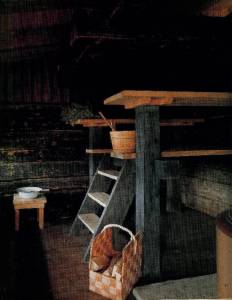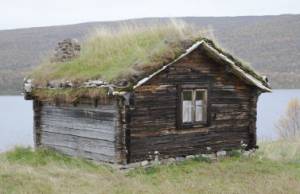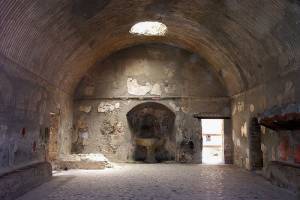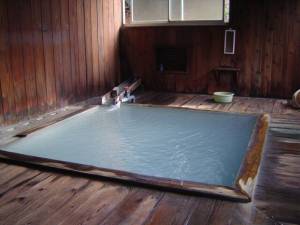Saunas are becoming one of the biggest selling health oriented commodities on the market today. They are beneficial to your health and an asset to your overall wellness plan. This article is about sauna history.
 Saunas began their life in Finland over two thousand years ago. The word ‘sauna‘ is Finnish for bath house and is the only Finnish word used in the English language.
Saunas began their life in Finland over two thousand years ago. The word ‘sauna‘ is Finnish for bath house and is the only Finnish word used in the English language.
One of the first Finnish sauna descriptions was wrote in 1112, and the earliest sauna was dug into an embankment in the ground. Later saunas were built above the ground for easier accessibility.
Even hundreds of years ago when bathing was done only rarely or never at all, the Finns were cleaning themselves in a sauna at least once a week.
Saunas are an important part of Finnish culture. They are a place to relax with friends and family as well as a place for physical and mental relaxation. Before the health care and nursing systems began almost all Finnish mothers gave birth in their sauna.
At this time it is estimated there are over 3 million saunas in Finland today and with a population of just over 5 million that works out to be an average of one per household. At Sauna Revolution, I hope to increase the amount of saunas in North America too!
Why Are Saunas So Important In Finland?
The warm wooden rooms could be used at lower temperatures, and were at the heart of the major events in their lives.
The traditional saunas were lined with natural bacterial soot, making them the cleanest room in the house.
Saunas were also used for purification rituals before marriage, and the bodies of the dead were washed and made ready for burial on wooden benches in the sauna.
The sauna was featured in all major events of the year. New Years, Easter, Lent, Midsummer and at harvest time. It was during these special times the Finns believed the spirits bathed in the sauna.
How Were These Saunas Built?
 The history of the sauna tells us that saunas were built from logs and were first introduced in Finland in the first couple of century’s of the common era.
The history of the sauna tells us that saunas were built from logs and were first introduced in Finland in the first couple of century’s of the common era.
These log saunas were heated by wood in a small stove that had no chimney. The room had a hole in the roof to allow the smoke to escape and the door was left open until most of the smoke had dissipated.
There would be a basket of rocks beside the stove that would get very hot. Then a small amount of water would be poured over them to create the steam. This could be repeated as many times as a person wished.
The sauna room was small with dim lights or a candle, no music and no smells other than natural tar and a bundle of fresh birch twigs that were tied together and used to gently whip the skin. This was very good for circulation and left the skin feeling refreshed.
The Finns believed the sauna not only cleansed the body but also the mind. No clothes were worn in the sauna, just like a bath.
How Were Saunas Used Throughout History?
The typical Finnish family use a sauna at least once a week. While the traditional sauna day is Saturday, it can be used as many times as they wish. Usually male and female go separately although members of the same family can go together (father, son) (mother, daughter).
Taking a sauna begins with a wash or shower, then they enter the sauna where they sit and relax in the warm steam. Typically the temperature ranges between 80-110 Celsius (176-230 Fahrenheit).
Water is thrown on the hot stones that are placed on the special stove used to warm up the room. This produces a large amount of wet steam, increasing the moisture and the heat with in the sauna.
Occasionally a bunch of silver birch twigs are used to whip the body, this has a relaxing effect on sore muscles, improves circulation and soothes the skin.
After anywhere from 30 minutes to an hour, or when the heat begins to feel uncomfortable it is customary to run out and jump into cold water. This maybe a hole in the ice of a lake or sea or you could take a roll in the snow.
Quite often this whole cycle is repeated two or three times, even more on certain occasions.
Do Other Cultures Use Saunas?
The answer to that question is without a doubt, Yes. While they may differ in some aspects from a Finnish sauna the basic use and benefits remain the same. Throughout all of history, many cultures used a sauna. All of these saunas were different in some way.
 In Mexico and central America there is a version of the sauna called a temazcal. It is the Mexican version of the sweat lodge, used by indigenous people of America and is usually made of clay or stone rather than wood.
In Mexico and central America there is a version of the sauna called a temazcal. It is the Mexican version of the sweat lodge, used by indigenous people of America and is usually made of clay or stone rather than wood.
Some archaeological sites in Greenland and Newfoundland have uncovered the remains of sauna like structures, very similar to Scandinavian farm saunas. Some with what appears to be bathing platforms and a large quantity of badly scorched stones.
The sweat lodge is a low hut, typically dome shaped and made of natural materials. While this structure is called the lodge the ceremony may be called a purification ceremony or simply a sweat.
This hut or lodge is heated by steam from water poured over very hot stones, it is used for rituals or therapeutic sweating, especially by American Indians.
With the help of their medicine man, they could repair the damage to their spirits, their minds and their bodies. The sweat lodge is a place of spiritual refuge and mental and physical healing.
The lodge in earlier times was covered in hides of buffalo, bear or moose. But in this day and age the animal skins have been mostly replaced with blankets, plastic sheeting, old carpet, heavy canvas sheets and tarps to retain the heat and steam.
Sweat lodges are still used today for a broad range of purposes, depending on the occasion. Most ceremonies are to give thanks, to heal, to seek wisdom, and to purify the mind.
Ancient Roman Bathing
 You can’t discuss sauna history without bringing up Roman Bathhouses.
You can’t discuss sauna history without bringing up Roman Bathhouses.
Bathing played a very important role in Roman times and was one of the most common daily activities in Roman culture. It was practised across a wide variety of social classes.
Though many cultures see bathing as a private activity, the Romans saw it as communal. While the wealthy could afford bathing facilities in their home, most people used the communal baths.
In some ways these baths were like modern day spas. The Romans raised bathing to a high art as they socialized in these communal bathing houses.
Communal baths were available in temples, and courtship and even business deals were conducted in them. Such was the importance of these baths they began to build lavish ones on natural hot springs.
Although small bath houses were mostly privately owned, they were public in the sense that they were open to the public for a fee. The larger ones were owned by the state and often covered several blocks.
The largest of these, the baths of Diocletian could hold up to 3,000 bathers. Fees for both types of baths were quite reasonable and within the budget of most free Romans.
Greek mythology specified that certain natural springs or tidal pools were blessed by the gods and could cure diseases, offerings were left for the gods for healing at these sites.
The early primitive steam baths were cut into the hill sides from which the hot spring issued. Chambers cut into the rock above were for the bather to store their clothes.
The early ones used natural features, but then expanded to add decorations and shelves. They also had mosaic floors depicting drivers and chariots.
Romans emulated these practices and surpassed them in the size of the baths. With the expansion of the Roman empire, the idea of these baths spread to all parts of the Mediterranean, Europe and North Africa.
The Chinese Bath Houses
The old Chinese public baths often known as bathhouses were usually divided into two rooms. The inner one having a square pool filled with hot water for bathing and an outer room with beds so they could rest afterwards. They had a hand in shaping the history of the sauna.
The bathhouses used paper lanterns with candles hung from high posts for light. Some put the name of the bathhouse on their lanterns while others put their own name on them.
Before the 20th century people would rise before dawn to visit the bathhouse. After their bath students, male servants and merchants would then proceed to take up their respective duties.
Some of the first public bathhouses appeared as early as the 11th century. In an authentic bathhouse the attendants would call the customers ‘boss’, then hand each of them a small towel and lead them to their seats.
They then would receive a cup of hot green tea. After guests disrobe they are given a larger towel to use in the bath, so they did not to catch a cold.
Workers in the pool helped the guests to bathe, when they got out of the water the waiters used six warm towels to dry them with. After they are dry the waiter bids them farewell.
The modern bathhouses are huge and the greeters are girls, some even have entertainment and traditional saunas – a far cry from the days of old.
The Japanese Onsen
 Japanese onsen are natural hot springs, born from the country’s plentiful volcanic activity. The practice of soaking in these thermal baths for healing, spirituality and rejuvenation stems back to the 500 hundreds.
Japanese onsen are natural hot springs, born from the country’s plentiful volcanic activity. The practice of soaking in these thermal baths for healing, spirituality and rejuvenation stems back to the 500 hundreds.
Some sauna history evidence suggests Buddhist monks were responsible for some of the earliest ones around the country.
Some of these onsens have been around for thousands of years, and are placed around natural formations. One such place is believed to have been used for 3,000 years and is located on the island of Shikoku.
Onsens come in many shapes and sizes and can be indoor or outdoor and they may be publicly run by municipality or privately. This is often as part of a hotel or bed and breakfast.
Traditionally, onsens were located outdoors, they use natural hot water from geothermal heated springs. Onsens are different from indoor public bathhouses where the baths are filled with heated water.
The water in the onsen is believed to have healing powers derived from it’s mineral content. A particular onsen may have several different baths each containing water with a different mineral content.
Some onsens may promote the special mineral composition of their waters, together with other services such as massages.
Traditionally men and women bathed together. Gender separation has been enforced since the opening of Japan to the western world. Although bathing together may still exist in rural areas, usually they provide the option woman only or different hours for the two sexes.
Saunas Are Simply Good For Everyone
 Some form of heat and steam are used all over the world for saunas, bathhouses, sweat lodges and onsens. These are not only used to clean ourselves but also for many other purposes.
Some form of heat and steam are used all over the world for saunas, bathhouses, sweat lodges and onsens. These are not only used to clean ourselves but also for many other purposes.
In some cultures it is believed the spirits and gods have bathed in the waters thus purifying and cleansing it. So if you bathe in these waters it will not only heal your body but also your mind.
The health benefits of saunas and steam baths are endless. They can help remove toxins and cleanse the body, they are great for relaxing sore muscles, detoxifying and can aid in lowering your blood pressure.
Heat from a saunas soothes your nerve endings and warms and relaxes you, relieving the tensions from your body and minimizing joint pain. This is especially good for people suffering from arthritis, painful migraines and headaches.
Saunas can also be used to calm the body of people suffering from insomnia. It reduces the stress of everyday life, thus ensuring a better nights sleep. In modern times you can get many different varieties from barrels to stone and even ones for personal use at home.
The history of the sauna is a long one with endless benefits. We all deserve to be relaxed and pampered. And what better way than to enjoy a sauna? Whether it’s once a week or everyday you will soon notice a difference in your overall health and wellness.

Leave a Reply